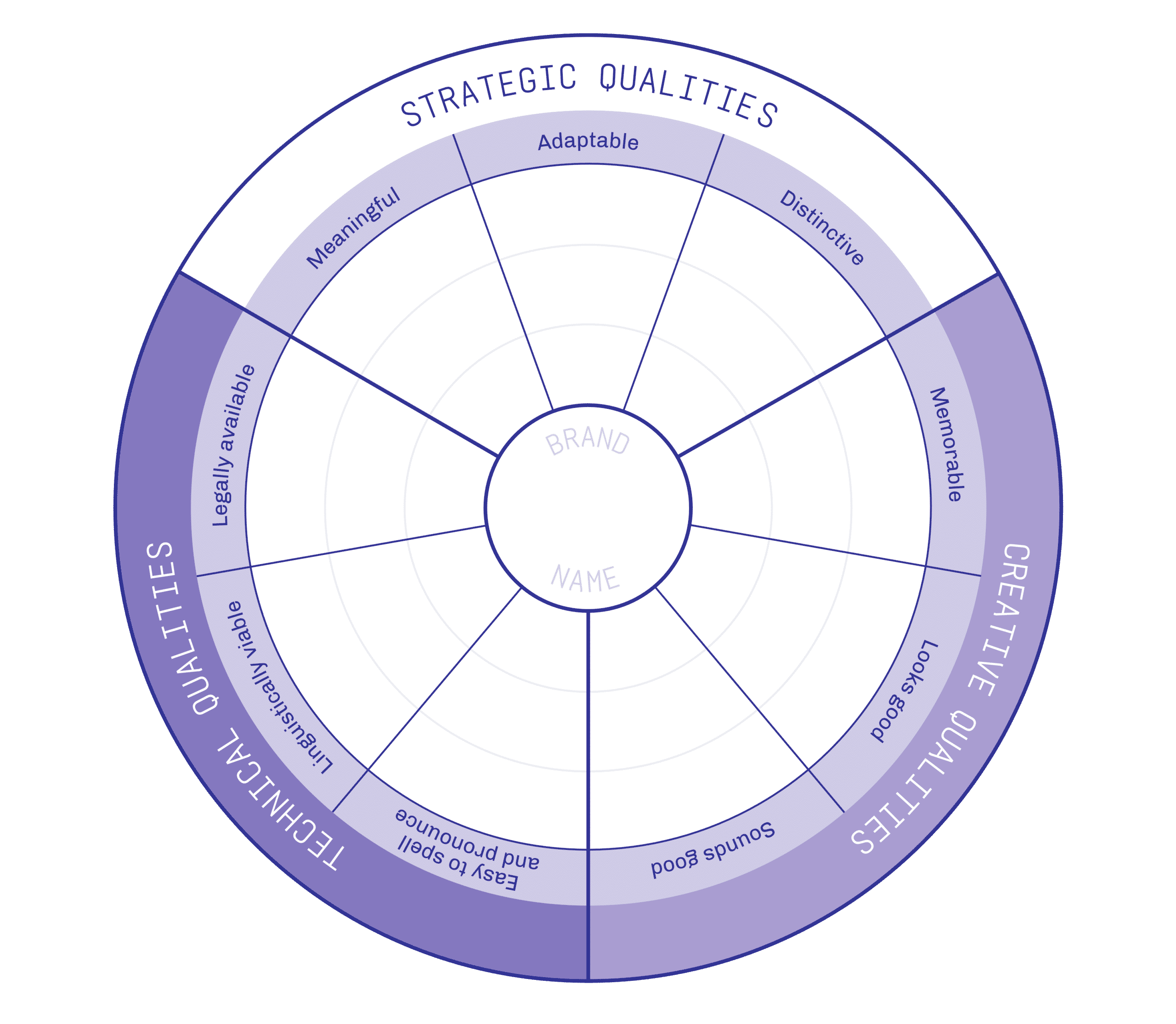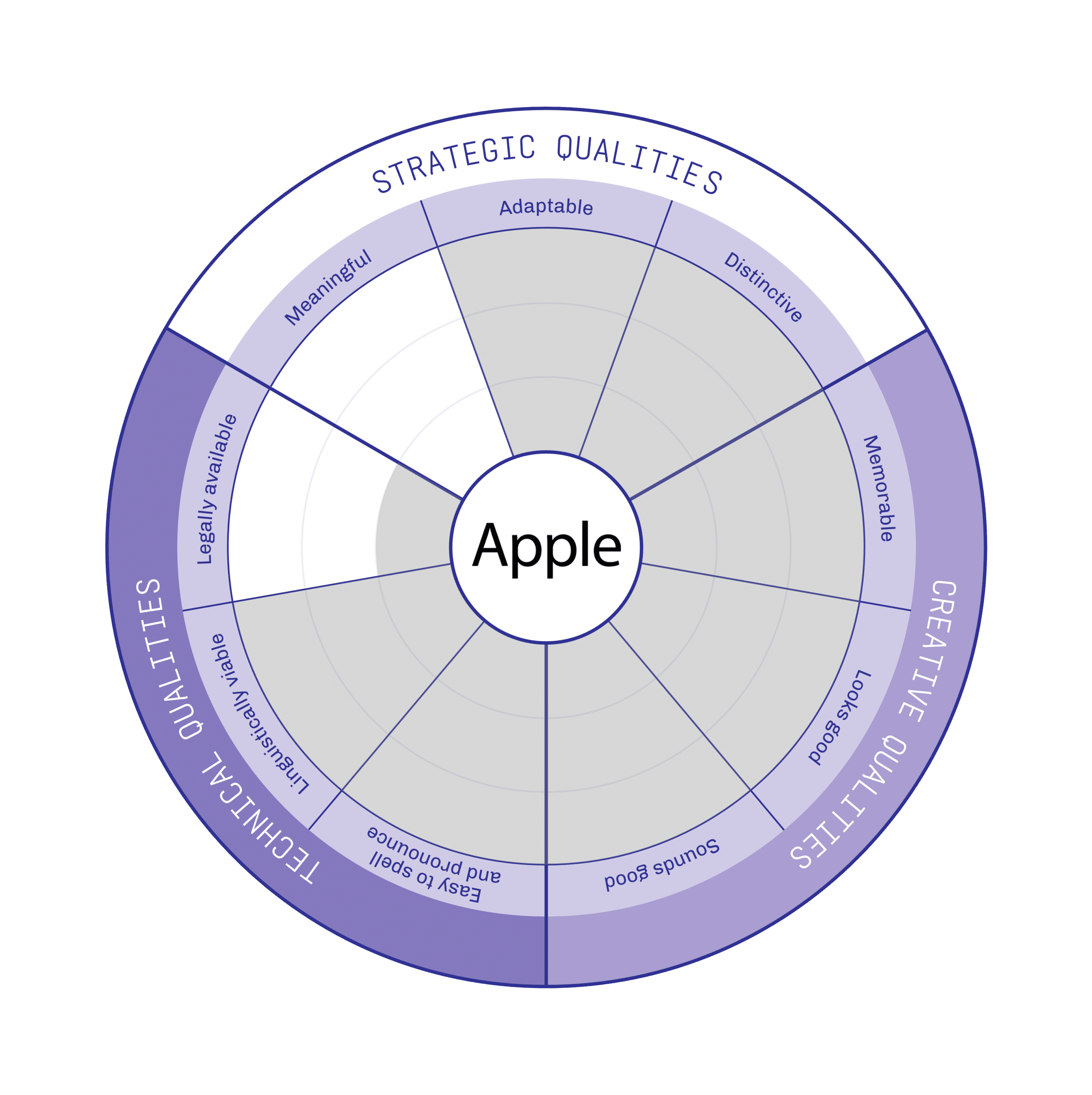This article was contributed by Rob Meyerson, author of Brand Naming, who provides us with a free tool on How to Evaluate Brand Names.
When I started writing Brand Naming, I knew I’d have to address some fundamental questions:

- What makes a good brand name?
- Why are some better than others?
- Is there an easy way to evaluate brand names?
After 15 years as a professional namer, I have standard answers to these question—ones that I share with clients in every naming project. But for the book, I felt I owed readers more than my professional opinion—so I did some research.
- Related: See our naming podcast with Rob Meyerson and our top naming courses.
It’s tough to find scientific evidence showing some names work better than others, but nearly every professional namer, branding book, and naming book has a unique list of characteristics they assert lead to a superior brand name.
To dig into the problem, I interviewed about a dozen namers, asking them how they evaluate brand names, and cross-referenced lists from every reputable source I could find.
After conducting all my research, I did two things that may seem contradictory:
- I decided these lists are a bit dumb—especially the fact that everyone seems to have their own list.
- I created my own list.
Let me explain. What makes the lists “dumb” is the way they’re presented—or interpreted, at least. Too often, they’re viewed as checklists of requirements for great brand names. But so much of what makes a great brand name depends on the context.
To succeed, your brand name doesn’t necessarily have to mean anything (e.g., Dasani). It doesn’t have to be all that exciting or edgy (e.g., Vitaminwater). It can be long and still work (e.g., National Geographic).
Rather than create my own “X qualities of great brand names” and another mnemonic for readers to memorize, I chose to focus on three broad categories of qualities that can lead to a strong brand name. I provided examples of qualities within each category, and in doing so, inadvertently created a handy tool that will help you evaluate otherwise similar brand names.
What makes a good brand name? – Categories of Qualities
The strongest brand names have the right mix of strategic, creative, and technical qualities. Each category contains multiple qualities, but if you’re simply careful to consider these three areas, you’ll be well on your way to a strong brand name.
To evaluate brand names, assess them through all three lenses—strategic, creative, and technical.
Strategic
The strategy will be different for different names, but three strategic qualities to consider are meaning, adaptability, and distinctiveness. As suggested above, sometimes the strategy will dictate that the name conveys a specific meaning or expresses a specific personality. Sometimes not.
Many brand names—especially at the company level—should be able to “stretch” in case the business changes (unlike RadioShack, which unsuccessfully tried to rebrand as “The Shack”). And most names—but not all—should strive for distinctiveness.
Creative
Creativity is in the eye of the beholder. But many great brand names are memorable, sound good, and look good. Memorability is one of the less debatable qualities of strong brand names, and can stem from a name’s distinctiveness (see above), its emotional potency, or its structure (e.g., brevity, rhyming, or powerful speech sounds).
When thinking about how to evaluate brand names, remember that customers will be hearing and seeing them, so consider how sonically and visually pleasing they are.
Technical
Lastly, names have to clear some technical hurdles: legal availability, linguistic viability, and ease of spelling and pronunciation. These qualities are more hard and fast than any in the strategic or creative categories, but even a name’s legal challenges can be overcome—some deep-pocketed organizations are willing to acquire smaller companies just for the rights to their names.
Ease of pronunciation seems like a must-have, but some brand names succeed in spite of—or even because of—their strange spellings and pronunciations. Häagen-Dazs, for example, may have benefited from sounding vaguely Danish in the ears of American consumers. (The name is, in fact, nonsense.)
How to Evaluate Brand Names – A simple free tool
To depict these categories and qualities visually, I created the graphic below.
After I’d created the graphic—let’s call it a name radar, just for fun—I thought it would be fun to use it to highlight the relative strengths and weaknesses of well-known brand names. Let’s take a look at two extreme examples: Apple and Tronc.
Apple
Often cited as a brilliant company name, Apple was selected because it “sounded fun, spirited, and not intimidating.” I agree, so on the radar, I’ll completely fill in the “sounds good” segment. It doesn’t mean much of anything relevant, so I’ll leave “meaningful” blank.
But it’s definitely distinctive, especially when compared to its contemporaries (e.g., Commodore, Microsoft, and IBM), so I’ll fill in the “distinctive” segment as well.
I’ll continue in this fashion, evaluating the name against each quality in the radar. Apple does well on many segments partly because it’s a simple, real English word. It’s adaptable (used for everything from a watch to a streaming video platform), memorable, fun to say, and easy to spell.
It’s probably linguistically viable for this reason, too, although it’s hard to know without doing some research. I also don’t know definitively how legally available it was (or how easy it is to protect), although the company has run into some trademark challenges in the past. I’ll leave that segment half full.
As you can see in the image below, despite being a great name, Apple doesn’t completely fill the radar.
 Tronc
Tronc
Now let’s evaluate a very different brand name. Tronc must be one of the most disliked names in history. It’s short for “Tribune Online Content,” and when the company dropped the abbreviated moniker, one headline read “Tronc to change name back to Tribune Publishing after years of ridicule.” It sounds gross (or silly, at least), looks bad, and means nothing.
It’s not hard to spell, but it’s not especially easy, either (“Tronk?” Trawnk?”). That said, it is quite memorable and distinctive, even if for the wrong reasons, and given its lack of meaning, one could argue that it’s adaptable, too.
From the outside looking in, it’s hard to know what legal or linguistic challenges a name like Tronc would have faced, so I’ll simply gray those segments out.
Evaluating these brand names by filling in the radars makes several points even more clear:
- These qualities are not requirements for good brand names. Think of them more as general guidelines to consider when creating or evaluating brand names.
- Some great brand names succeed because they excel on a small number of qualities. Other names fail by drastically missing the mark on just one quality.
- The qualities are not interdependent. Distinctive names tend to be more memorable. Names that sound good are sometimes easier to spell. Meaningless names are more adaptable.
- Despite the symmetry in the graphic, not all nine qualities are equally important. (Again, it depends on the context for the name.) Legal problems can—and often do—torpedo otherwise amazing name ideas.
- Ultimately, it’s about balancing the qualities across all three areas in a way that makes sense for the project at hand.
If you’d like to use this tool to evaluate your own brand name or to help you choose between a handful of name options for your company or product, you can download a worksheet version here.
But please, don’t refer to it as a “checklist.”
See here for more great naming resources.

 Tronc
Tronc